Ashmont (MBTA station)
ASHMONT | ||||||||||||||||
|---|---|---|---|---|---|---|---|---|---|---|---|---|---|---|---|---|
|
Red Line train at Ashmont | ||||||||||||||||
| Location |
1900 Dorchester Avenue at 200 Ashmont Street Dorchester, Massachusetts[1] | |||||||||||||||
| Coordinates | 42°17′03″N 71°03′50″W / 42.2843°N 71.0638°WCoordinates: 42°17′03″N 71°03′50″W / 42.2843°N 71.0638°W | |||||||||||||||
| Owned by | Massachusetts Bay Transportation Authority | |||||||||||||||
| Line(s) | ||||||||||||||||
| Platforms |
2 side platforms (Red Line) 1 side platform (Ashmont-Mattapan Line) | |||||||||||||||
| Tracks |
2 (Red Line) 1 (Ashmont-Mattapan Line) | |||||||||||||||
| Construction | ||||||||||||||||
| Parking | 100 spaces | |||||||||||||||
| Bicycle facilities | eight spaces | |||||||||||||||
| Disabled access | Yes | |||||||||||||||
| History | ||||||||||||||||
| Opened |
September 1, 1928 (Red Line) August 26, 1929 (Ashmont-Mattapan High-Speed Line) | |||||||||||||||
| Rebuilt | 2005-2011 | |||||||||||||||
| Traffic | ||||||||||||||||
| Passengers (2009) | 6,019 (weekday average boardings)[2] | |||||||||||||||
| Services | ||||||||||||||||
| ||||||||||||||||
Ashmont is located on the Red Line in Dorchester, Massachusetts. It opened on September 1, 1928, and is the subway terminal for the Red Line's Dorchester Branch. Ashmont is also the terminus of the light rail Ashmont–Mattapan High Speed Line, which loops around on an elevated viaduct.
Toward the end of the Ashmont renovations, new signs were put in that now read ASHMONT/PEABODY SQ., but this change will not appear on any new maps or publications.
Station layout
| G | Street Level | Exit/Entrance, headhouse |
| Side platform, doors will open on the right | ||
| Outbound | ← Ashmont–Mattapan Line toward Mattapan (Cedar Grove) | |
| P Platform level |
Side platform, doors will open on the right | |
| Outbound | ← Red Line alighting passengers only | |
| Inbound | → Red Line toward Alewife (Shawmut) → | |
| Side platform, doors will open on the right | ||
History
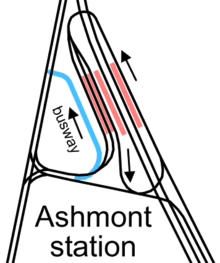
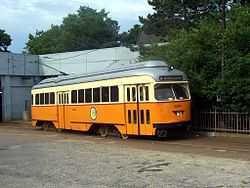
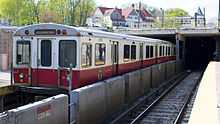
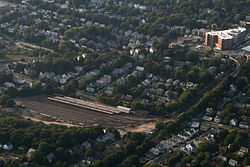
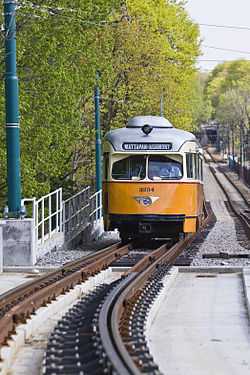
The first Ashmont Station was a simple building along the original Shawmut Branch of the Old Colony Railroad, which opened in 1872. That was when steam locomotives powered the passenger trains that continued into Boston with a stop at Fields Corner. The current intermediate Shawmut Station was not created as a train stop until the Shawmut Branch of the steam railroad was adapted to electrified subway service in the late 1920s and placed underground as it approached Ashmont Station.
When first built in 1928, no buses served the station; all lines ran streetcars. Specifically, the following Boston Elevated Railway streetcar lines operated to Ashmont (using post-1942 numbers), unloading on the east side and loading on the two west tracks on the west side:
- 22 Ruggles via Talbot Avenue
- 23 Ruggles via Washington Street, Dorchester
- 27 Mattapan Station via River St.
Eastern Massachusetts Street Railway cars to Brockton also used the station.
Two streetcar lines serving the area west of Ashmont were bustituted soon after opening, later becoming the 25 and 26 buses. They were rerouted to Ashmont for faster access to downtown. A new busway was built on the west side of the station in 1929; this has since been connected to the old streetcar ramps. The first section of the Mattapan High Speed Line (originally 28) also opened in 1929, serving the easternmost track on the west side.
The Eastern Massachusetts Street Railway line converted to bus in 1932, using the busway. The 27 was bustituted in 1933, and a new route (24, renumbered 12 ca. 1967) serving the area east of the station was also added. Additionally the Eastern Mass started running buses over what are now the 215 and 217 routes.
The ramps were paved, and in 1949 the trolleybus replaced the 22 and 23 lines.
Reconstruction
In 2005, the MBTA awarded a $35.2 million contract for the complete reconstruction of the 75-year-old Ashmont station. The station was razed by September 2007 and the station was completely rebuilt. Trolley service was interrupted for 18 months, but was restored in December 2007.[3] The reconstruction was completed in 2009, while architectural work lasted until the summer of 2011.[4] Highlights of the project included:[5][6]
- New platforms and an elevated viaduct for the Ashmont-Mattapan High Speed Line
- Two new lobbies with access at the station
- An elevated busway that is level with the new lobbies
- Public access over the subway tunnel to Peabody Square
- Three new elevators and two new escalators
- CCTV security cameras and significantly enhanced lighting
- Charlie Card automated fare vending machines and fare gates
The station construction included of a first-of-its-kind transit oriented development (TOD) on the station site. The 116 units of mixed income housing represent the state, city, MBTA, community and a private developer's combined effort to provide housing adjacent to rapid transit, thereby reducing automobile usage.[4][5]
In September 2011, a "HOLD" sign was installed on the trolley platform to allow an easier connection for those transferring from the Red Line.[7]
Accessibility
After the reconstruction, the station is wheelchair-accessible for both the Red Line and the Ashmont-Mattapan trolley line. See MBTA accessibility.
Bus connections
MBTA bus lines
- 18 - Andrew Sta. via Fields Corner
- 21 - Forest Hills Sta. via Morton St.
- 22 - Ruggles Sta. via Talbot Ave.
- 23 - Ruggles Sta. via Washington St.
- 27 - Mattapan Sta. via River St.
- 215 - Quincy Center Sta. via W. Quincy
- 240 - Avon Square or Holbrook/Randolph Commuter Rail Sta.
Other bus lines
- BAT12 - Brockton (operated by Brockton Area Transit)
References
- ↑ "Ashmont". Massachusetts Bay Transportation Authority. Retrieved 3 October 2011.
- ↑ "Ridership and Service Statistics" (PDF). Massachusetts Bay Transportation Authority. 2010. Retrieved October 28, 2012.
- ↑ "Commuter Rail service is back after a barge hits a bridge". WHDH-TV. December 22, 2007. Archived from the original on 23 December 2007. Retrieved 2007-12-24.
- ↑ 4.0 4.1 "Ashmont Station Renovation". Massachusetts Bay Transportation Authority. Retrieved 1 October 2011.
- ↑ 5.0 5.1 "MBTA > Ashmont Station Renovation". MBTA. Archived from the original on 30 September 2007. Retrieved 2007-09-30.
- ↑ MBTA. "Bid Responses" (PDF). Ashmont Station Community Website. Retrieved 2007-09-30.
- ↑ Rosso, Patrick (16 September 2011). "Mattapan commuters get a little extra time to catch the train". Boston Globe. Retrieved 3 October 2011.
External links
| Wikimedia Commons has media related to Ashmont (MBTA station). |
- MBTA - Ashmont Station (Red Line)
- nycsubway.org - MBTA Red Line
- Ashmont Station Community Website (Red Line)
- Cambridge Seven Associates project page
- Station from Google Maps Street View
| ||||||||||||||||||||||||||||||||||||||||||||||||||||||||||